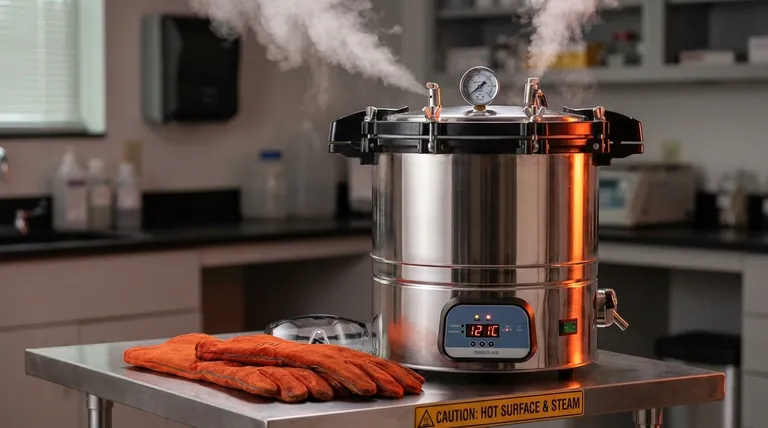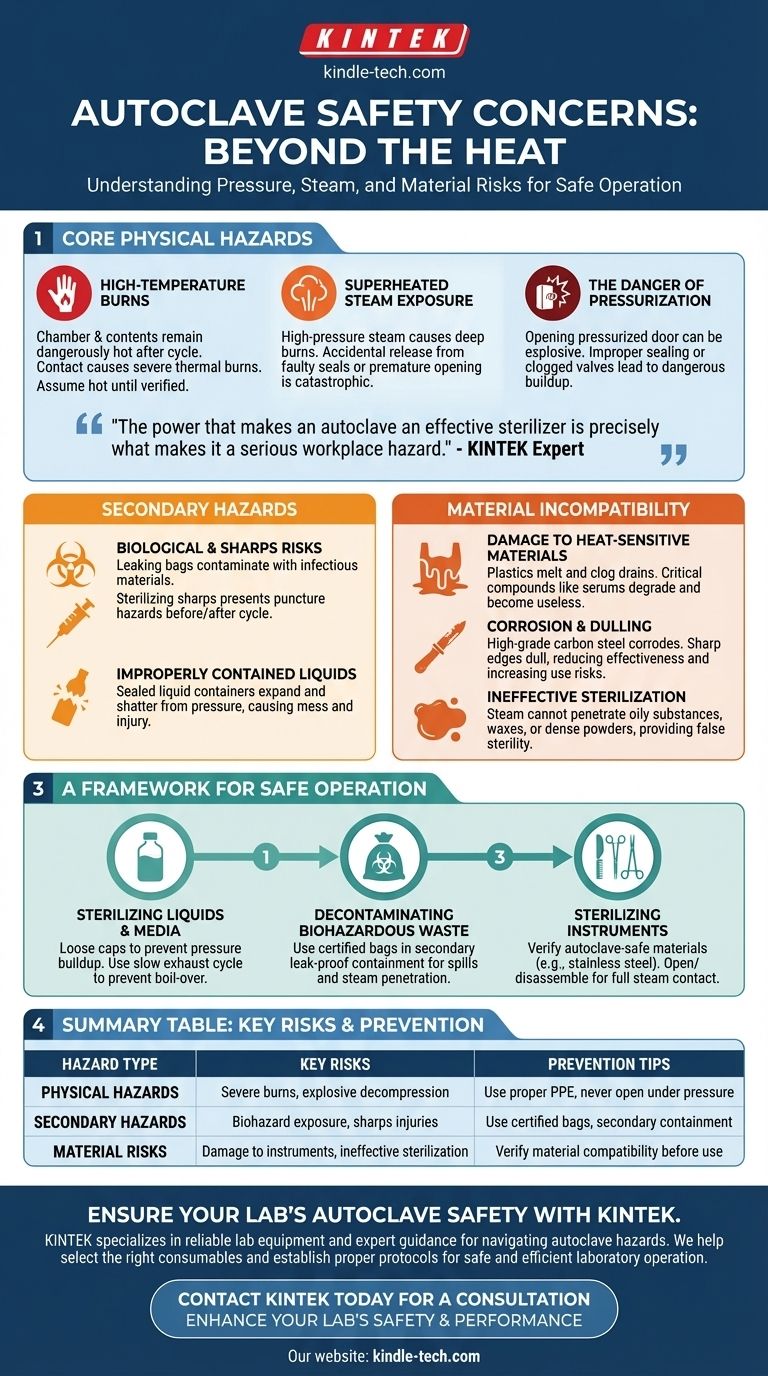Beyond the obvious heat, the primary safety concerns with autoclaves stem from the immense pressure and superheated steam required for sterilization. These machines operate at temperatures exceeding 121°C (250°F) and pressures of at least 20 psi, creating significant physical hazards. The most critical risks include severe burns from hot surfaces and steam, explosive decompression from improper operation, and exposure to the very biological or physical hazards you intend to sterilize.
The power that makes an autoclave an effective sterilizer is precisely what makes it a serious workplace hazard. True safety is not just about avoiding burns; it requires a deep understanding of the entire process—from correct material selection and loading to respecting the pressure cycle—to prevent equipment failure and injury.

The Core Physical Hazards: Heat, Steam, and Pressure
An autoclave is a pressurized vessel, and its core dangers are rooted in fundamental physics. Understanding these three elements is the first step toward safe operation.
High-Temperature Burns
An autoclave's chamber and its contents remain dangerously hot long after the cycle completes. Contact with the interior walls or recently sterilized items can cause severe thermal burns. Always assume any surface is hot until verified otherwise.
Superheated Steam Exposure
The steam inside an autoclave is not only hot but also under high pressure. Accidental exposure to escaping steam—from a faulty seal or opening the door prematurely—can cause immediate, deep burns that are often more severe than those from hot water. Pockets of residual steam can also be released when unloading items.
The Danger of Pressurization
This is the most catastrophic risk. If an autoclave door is opened while the chamber is still pressurized, it can be thrown open with explosive force, ejecting scalding contents. Conversely, an improperly sealed door or a clogged safety valve can lead to a dangerous buildup of pressure beyond the machine's structural limits.
Secondary Hazards: What You Put Inside Matters
The risks are not limited to the machine itself. The materials you place inside introduce another layer of potential hazards related to their biological nature and physical properties.
Biological and Sharps Hazards
When decontaminating waste, the load itself is inherently dangerous. A leaking autoclave bag could contaminate the chamber and surrounding area with infectious materials. Likewise, sterilizing sharps like needles or scalpels presents a physical puncture hazard both before and after the cycle.
Improperly Contained Liquids
Never seal a container of liquid completely. As the liquid heats up, it expands, and the trapped air pressure increases dramatically. This can cause the container to shatter inside the autoclave, creating a mess of broken glass and potentially compromising the cycle or causing injury upon unloading.
Understanding the Trade-offs: Material Incompatibility Risks
Not every item can or should be autoclaved. Attempting to sterilize incompatible materials is a common mistake that can damage the items, the autoclave, and create safety risks.
Damage to Heat-Sensitive Materials
Many materials cannot withstand the high temperatures of an autoclave. Plastics can melt, clogging drains and vents, which may lead to a pressure regulation failure. Critical compounds in solutions, such as serums or certain vaccines, can be degraded and rendered useless by the heat.
Corrosion and Dulling of Instruments
While stainless steel is generally safe, high-grade carbon steel instruments can be damaged by the moisture and heat, leading to corrosion and rust. Furthermore, the high heat can dull the sharp edges of scalpels and scissors, reducing their effectiveness and creating a different kind of safety risk during use.
Ineffective Sterilization of Oils and Powders
An autoclave works by using penetrating steam. It is completely ineffective for oily substances, waxes, or dense powders because the steam cannot make contact with and sterilize the material. Attempting to do so provides a false sense of sterility, which is a major process and safety failure in any clinical or laboratory setting.
A Framework for Safe Operation
Safe autoclave use depends on a methodical approach to loading, running, and unloading. Verifying each stage is critical to preventing accidents.
- If your primary focus is sterilizing liquids and media: Ensure container caps are loose to prevent pressure buildup and use a slow exhaust cycle to prevent the media from boiling over.
- If your primary focus is decontaminating biohazardous waste: Always use certified autoclave bags within a secondary, leak-proof containment pan to manage potential spills and ensure steam can penetrate the load.
- If your primary focus is sterilizing lab or surgical instruments: Double-check that all instruments are made of autoclave-safe materials (like stainless steel) and are opened or disassembled to allow full steam contact.
Approaching an autoclave with a systematic respect for its power is the foundation of safe and effective sterilization.
Summary Table:
| Hazard Type | Key Risks | Prevention Tips |
|---|---|---|
| Physical Hazards | Severe burns, explosive decompression | Use proper PPE, never open under pressure |
| Secondary Hazards | Biohazard exposure, sharps injuries | Use certified bags, secondary containment |
| Material Risks | Damage to instruments, ineffective sterilization | Verify material compatibility before use |
Ensure your lab's autoclave safety with KINTEK.
Autoclaves are powerful but present significant risks if not managed correctly. KINTEK specializes in providing reliable lab equipment and expert guidance to help you navigate these hazards. From selecting the right autoclave-safe consumables to establishing proper sterilization protocols, we ensure your laboratory operates safely and efficiently.
Our team is ready to assist you in choosing the right equipment and developing a safety framework tailored to your specific needs—whether you're sterilizing liquids, decontaminating waste, or processing surgical instruments.
Contact KINTEK today for a consultation and enhance your lab's safety and performance.
Visual Guide

Related Products
- Portable High Pressure Laboratory Autoclave Steam Sterilizer for Lab Use
- Laboratory Sterilizer Lab Autoclave Pulsating Vacuum Desktop Steam Sterilizer
- Laboratory Sterilizer Lab Autoclave Herbal Powder Sterilization Machine for Plant
- Laboratory High Pressure Steam Sterilizer Vertical Autoclave for Lab Department
- Desktop Fast Laboratory Autoclave Sterilizer 35L 50L 90L for Lab Use
People Also Ask
- What are the specifications of a laboratory autoclave? A Guide to Key Features for Safe Sterilization
- What are the two types of autoclave used in the laboratory? Gravity vs. Pre-Vacuum Explained
- What kind of hazard can a lab personnel experienced in working with autoclave? Avoid Complacency with These Critical Risks
- What is the temperature of autoclave 132? A Guide to High-Speed Sterilization Cycles
- What is the temperature of autoclave in microbiology lab? Achieve Sterile Conditions with 121°C



















